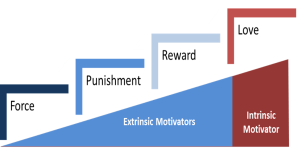Why do some students languish unmotivated at school, counting the days until summer vacation, whereas others are so motivated that they can scarcely stand the thought of three months away from their desks?
Schools have many options at their disposal for motivating students. Selecting the right motivator for each circumstance is critical to boosting student achievement. Love of learning is arguably the most powerful intrinsic motivator, and yet for many administrators and teachers, the idea of designing schools around experiences that bring students joy feels frivolous compared to other options for compelling behavior. What are the other options for motivating students, apart from providing experiences that students innately love?
One option is brute force. Schools could chain students to their seats to try to coerce learning. Youth detention centers sometimes have no choice but to lock students in their classroom for the duration of the lesson. In some circumstances, force is in fact the most appropriate motivator; for example, if a kindergartener runs into a busy street without regard to oncoming traffic, a good teacher would surely want to grab that child by the arm and pull her to safety.
Another option is punishment. Not too far in our past, corporal punishment was regarded as an appropriate means of requiring students to pay attention in class. More common today are detention slips, the principal’s office, suspensions, and bad reports to parents. Yelling at students is another common choice in the punishment category.
A third option is rewards. Some teachers use a system akin to the Good Behavior Game, first tested in 1969, which is an approach to classroom management based on rewarding students for on-task behaviors during instruction. Good behavior earns privileges, such as extra free time or recess. Research shows that the Good Behavior Game has positive effects on increasing on-task behaviors. Additional research by Allans and Fryer deepened the understanding of how to design incentive programs that improve achievement at relatively low cost.
Force, punishment, and rewards can all be appropriate in some circumstances. But they share a major limitation—they all rely on extrinsic motivation. They depend on an outsider to motivate learning, and if that person is distracted or away (heaven help the substitute teacher), the student will drift. In some cases extrinsic motivators actually promote poor behavior if they encourage students to cheat to avoid the punishment or win the prize.
The alternative is to motivate students to learn by making school intrinsically motivating. When learning is joyful and desirable, students are hungry to learn on their own, without outside persuasion. Mahatma Gandhi said that “power based on love is a thousand times more effective and permanent then the one derived from fear of punishment.” Love of learning is at the top of the motivation ladder.
Motivation Ladder
What does school look like when joy is the bedrock of learning? Students are reluctant to put their beloved books down at the end of free-read time. Children huddle together to continue a discussion about an interesting question, even after class is out. Students keep building their diorama, working on a math equation, or investigating a subject purely out of internal desire. I wrote here about the flow that emerges when students experience joy in learning. Even long summer vacations lose their appeal at some point.
Research suggests that two elements are especially capable of helping students love school. First, students need to feel successful. They need to feel that they are making progress and accomplishing something, rather than experiencing repeated failure or hitting up against walls. Second, they need to have fun with friends. When those two conditions are met, school is on track to become a place that connects the process of learning with joy.
Integrating the right experiences together to deliver these elements is a topic for another day. But educators can take the first step by reflecting about whether their environments are set up with the intention to produce love of learning, rather than fear of or hope for some external thing.


